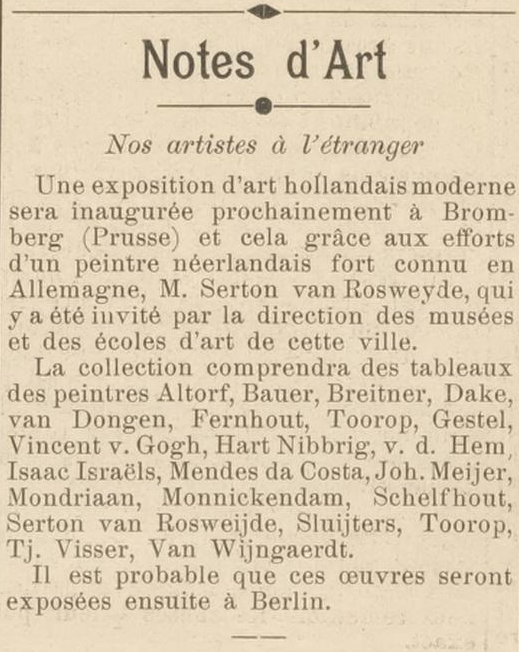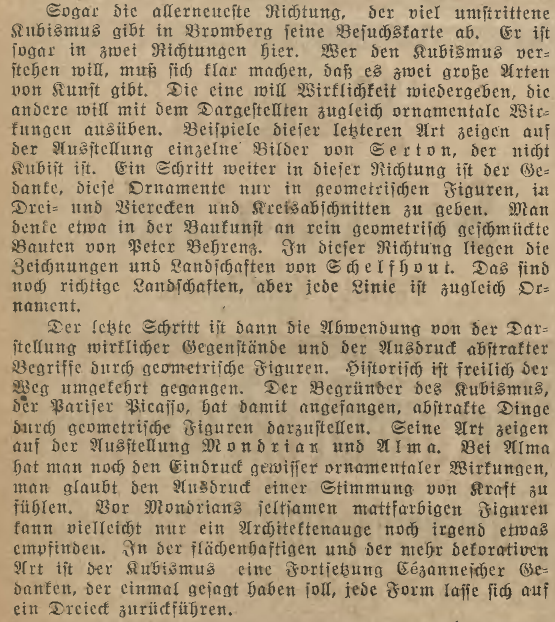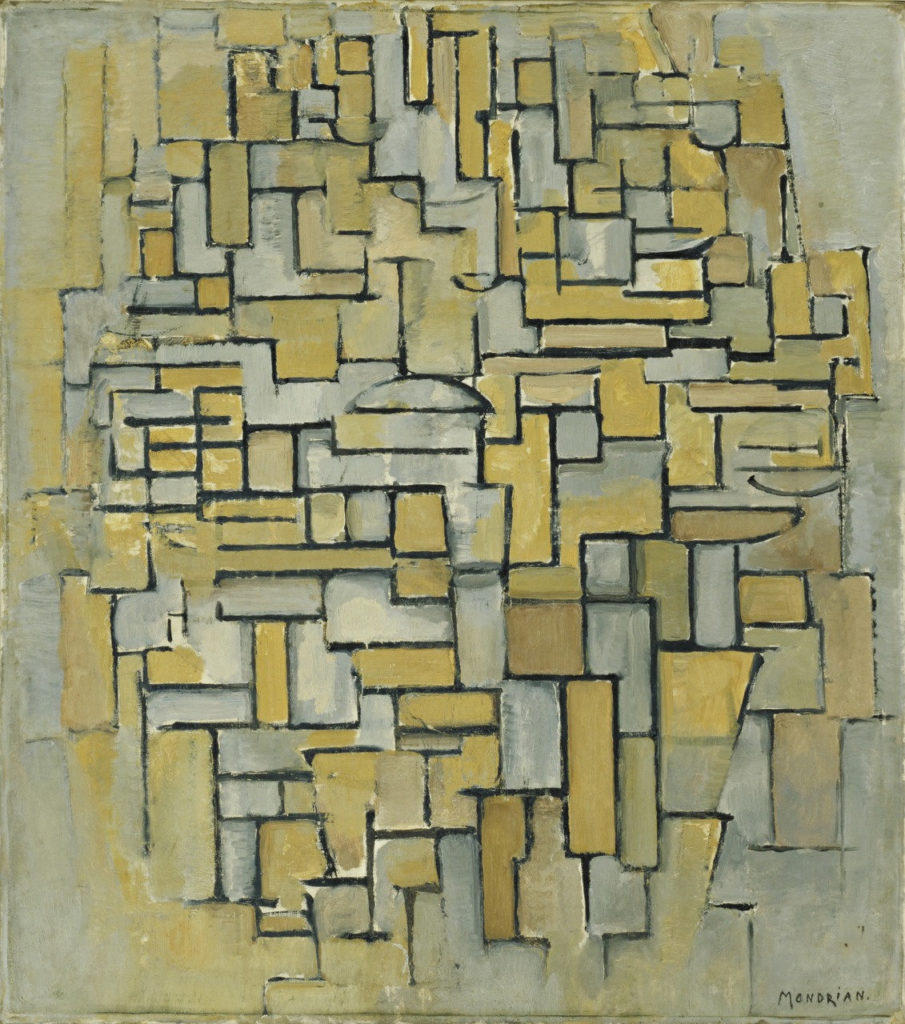by Laurens Kleine Deters

In October and November 1913 an exhibition of modern Dutch art, which had until recently remained more or less unknown, took place in the Prussian city of Bromberg. Reviews reveal that the artists representing ‘cubism’ were Piet Mondrian and his friends Peter Alma and Lodewijk Schelfhout.
It is often the case that when you try to find something, you encounter another point of interest. In this way, as we were looking for mentions of an exhibition in Russia which might have included work by Mondrian, we serendipitously stumbled across a short article in the Gazette de Hollande of 27 September 1913 [fig. 2].

The Gazette was a weekly magazine published in The Hague focusing on political and economic news and aiming primarily at foreign readers. In the article was a mention of an exhibition of modern art in Bromberg, then in Prussia, now known as Bydgoszcz in Poland. The driving force behind this exhibition was the Dutch painter Piet A. Serton van Rosweyde (1888-1914), who was ‘well-known in Germany’, but is more or less forgotten in The Netherlands today. We know very little about Serton’s life. One certain fact is that he was active in Paris from 1912, and exhibited in the spring of that year at the Salon des Indépendants. Possibly it was here that he first encountered Piet Mondrian’s work. In any case we know that he was the person that selected Mondrian’s work for the show in Bromberg.
From the annual report of the Bromberg Society for Art and Science we know that the exhibition mentioned did indeed take place: ‘The programme for the winter of 1913/14 began on 25 October 1913 with an exhibition of modern Dutch art, which was shown together with the School of Decorative Arts in their galleries, and ran until 20 November’. The report also reveals that the works selected by Serton provided an overview of modern Dutch art from Breitner and Israëls up until the cubists. Also among the works exhibited were a dozen paintings by Vincent van Gogh, something about which little was previously known.

On 29 October 1913 both the Bromberger Zeitung and Bromberger Tageblatt printed the same review of the exhibition by Georg Schwidetzky [fig. 3]. He describes Mondrian’s contribution as art which had gone furthest in ‘diverging from the representation of real objects’ – i.e. abstraction. Indeed, Mondrian had sent in at least two very recent abstract paintings. The slightly conventional works of Alma and Schelfhout were met with some enthusiasm by the reviewer, but he was less positive about the paintings by Mondrian: ‘Perhaps only the eye of an architect can find something to appreciate in Mondrian’s strange compositions in flat colours.’ Moreover, in January 1914, that is once the exhibition was finished, Schwidetzky published an extended, more descriptive account in Aus dem Posener Lande: Monatsblätter für Heimatkunde, in which he presented the exhibiting artists, including Mondrian and Alma, in a fictional dialogue. This publication is especially interesting for the reproductions it contains of several of the works that were exhibited. One of the illustrated works is a painting by Mondrian [fig. 1]: Gemälde No. I of 1913 (B40), which was bought in 1914 by H.P. Bremmer and is now in an American private collection. In Bromberg, Mondrian also exhibited a painting titled Gemälde No. II, that was unfortunately not reproduced.
Identification
Thanks to the reproduction we now know for certain that Gemälde No. I (B40) was exhibited in Bromberg. This allows us to identify another painting by Mondrian, which was shown at the same time at the Erster Deutscher Herbstsalon in Berlin. That work was similarly sent in with the title Gemälde No. I, which must refer to the painting now in the collection of the Stedelijk Van Abbemuseum (B38), that indeed still has this title on the back. This does not permit us to identify, however, which of the two known paintings with the title Gemälde No. II was shown in Bromberg, and which in Berlin. For these, there are two candidates: the painting which has since 1950 been in the collection of the Museum of Modern Art (B36) [fig. 4] and the work which entered the Stedelijk Museum Amsterdam (B39) in 1949 [fig. 5].


Did Mondrian choose to show in each exhibition one vertical and one horizontal painting? Or did he decide to have two horizontal compositions in one exhibition, and two vertical in the other? Mondrian experts Joop Joosten and Hans Janssen assumed that the two pairs of works were B38-B39 and B36-B40, but there is not enough information to confirm this.
Whichever combination of paintings Mondrian showed in Bromberg, neither work was sold, as emerges from a remark in a letter to Lodewijk Schelfhout dated 12 June 1914: ‘I also showed a few times in Germany, and sold nothing there either’. This is all the more remarkable, because ten years later, Mondrian succeeded in finding a good market in Germany for his even more abstract neoplastic work.
And by the way: Mondrian did not show work at the Russian exhibition.